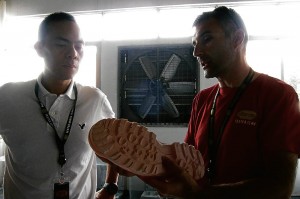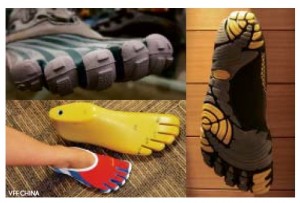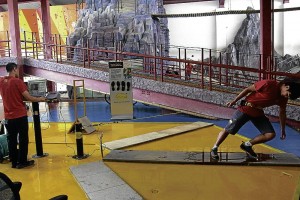
It’s a shoe that demands attention simply by looking, well, ridiculously conspicuous. They look like gloves, except this pair is for your feet—complete with five toe pockets to fit snugly over your five toes.
The design might take some getting used to, but Vibram Fivefingers is all about reaping the benefits of a barefoot lifestyle without actually going barefoot. In other words, developing stronger feet without staining them with dirt.
In the Philippines, the barefoot lifestyle is invariably linked to running. Barefoot running has been slowly gaining ground in the local running community the past couple of years. Hard-core advocates publicly expound its benefits, drawing the fascination of many runners.
Correcting form and gait
The barefoot lifestyle is said to naturally make your body walk or run the way it should, automatically correcting form and gait. To see for yourself, walk around your house wearing shoes or slippers. Next, remove your shoes, including socks if you’re wearing a pair, and walk the same route barefoot.
Notice how your step becomes lighter and your strides shorter, landing on the balls of your feet instead of the heels. That, say barefoot advocates, is how nature intended you to walk/run. If you run the way your body is designed to, injuries and pain disappear or are kept at a bare minimum.

“With traditional footwear most people land on the heel, rolling toward the ball and the forefoot. That impact is very sudden and sharp. That’s why traditional shoes have high-cushioned heels. With barefoot running, you will naturally land on the balls of your feet toward the lateral side,” said Matteo Crovetto, general manager at Vibram China, Vibram Technological Center in Guangzhou, China.
Extensive studies made by Robbins, SE, and Gouw, GJ, in the ’90s state that wearers of expensive running shoes, those with thick heel cushions, experienced “a greater prevalence of running-related injuries” than wearers of less expensive shoes (read: thinner cushions).
Running barefoot, on the other hand, makes the runner compensate by plantar-flexing the foot upon contact with the ground for the soft landing. Since barefoot runners land mid-foot, it increases the work of the foot’s soft-tissue support structures, making it stronger and possibly reducing the risk of injury, said Dr. Michael Yessis, multisports specialist in biomechanics.
Crovetto, however, is conservative about making claims. “We get reviews like that all the time, about how minimalist/barefoot running has corrected their flat feet that they actually began to form arches, for example. It’s nice, but if we make a claim like that and some people don’t see results—maybe because they didn’t wear it long enough or maybe because it just really didn’t work for them. Then that would give a brand a bad name,” he said.

There are, however, five reasons to go barefoot, backed by years of scientific studies. The Vibram Fivefingers delivers health benefits by leveraging the body’s natural biomechanics so you “move the way nature intended.”
Range of motion
Going barefoot strengthens the muscles in the feet and lower legs, improving general foot health and reducing the risk for injuries. Since it is now able to move freely, it improves range of motion in the ankles, feet and toes. Going barefoot also stimulates neural function important to balance and agility. It eliminates heel lift to align the spine and improve the posture because the body weight is now evenly distributed across the footbed. Finally, it allows the body to move naturally.
Transition to barefoot or minimalist running from traditional shoe should be very smooth. Crovetto recommends wearing it a few minutes during short runs at the start. Switch between traditional and Vibram Fivefingers. It may take a lot of work, he said, so you must respect your feet and give it time to adjust.

A good landing should feel relaxed and gentle. Do not over-stride. As long as your foot lands beneath your hips, the way you do when you’re doing jumping jacks, you’re doing good. If you’re still not convinced you’re running properly, run completely barefoot on a hard but smooth, debris-free pavement. The sensory feedback from your feet should tell you if you’re landing too hard.
Land with your foot nearly horizontal so you won’t work your calves too hard or put too much stress on your forefoot. Bring down the heel gradually, when the ball of your foot touches the ground. Form should be similar to landing from a jump—hip, knee and ankle flexed.
The Vibram Technological Center in China designs, manufactures and tests every new shoe designed. So far, the Vibram Test Team, a group of elite athletes selected especially to test the shoes in different surfaces, has already covered more than 1 million km.

“Every product that Vibram puts in the market has to pass the test and earn certificates from labs to ensure quality,” said Federico Furia, quality director at Vibram China.
Vibram Fivefingers offers footwear for a variety of sports, including mountain climbing, trek and travel, running, yoga/fitness, water sports and even lifestyle shoes. Founded 75 years ago by Italian Vitale Bramani (Vi-Bram), an avid mountain climber, the first shoes were designed to provide better grip and traction when climbing.
Today, a leading European company known for their track record in creating premium quality soles for many major sports brands, and even providing soles for shoes of the US military and tires for Nasa’s outer space robots and machines. Vibram then launched the Vibram Fivefingers in 2006, earning the citation as Best New Invention by Time magazine in 2007.











































